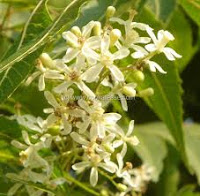 |
| A Neem product for every ailment: You name it! Image from tulipabeauty.co.uk |
Due to its antibacterial, anti-fungal and anti-parasitic properties, Neem is used to treat a myriad of illnesses ranging from lice, skin disorders to diabetes, ulcers and gastritis (McIntyre, 2005).
Mouthwashes containing compounds such as chlorhexidine are used to treat gingivitis and periodontitis (Botelho et al., 2008). However due to their side-effects, Neem is now being used increasingly in herbal mouthwashes (Botelho et al., 2008).
 |
| Neem mouthwash. Image from neemtreefarms.com |
To evaluate Neem’s anti-plaque and anti-gingivitis properties, Botelho et al. conducted a clinical trial on 55 patients who had not used antibacterial mouthwash for the last month (2008). For seven days, the experimental group used Neem leaf based mouthwash and the control group used chlorhexidine for 30 seconds twice a day (Botelho et al., 2008). Streptococcus mutans in saliva, plaque and gingival indexes were measured at 7 days and 1 month (Botelho et al., 2008). Results showed that the gingival index decreased from 1.52 to 0.45 in the Neem group and from 1.63 to 0.42 in the control group (P<0.001) (Botelho et al., 2008). Plaque index values decreased from 1.62 to 0.71 and 1.75 to 0.45 (P<0.001) in the respective groups (Botelho et al., 2008). No statistically significant differences were observed between the two groups (Botelho et al., 2008). However since long term use of chlorhexidine is limited by altering taste and staining of teeth, Neem could be used as a substitute (Botelho et al., 2008).
This study is a level 1 study being a double blind, randomized study where subjects and investigators were masked during treatment (Carter, 2010). Baseline parameters such as teeth number/condition, diet, smoking habits, and living conditions were similar, thus eliminating biases. Additionally sufficient background knowledge and information about excluded subjects was provided. Although the neem treatment produced mild side effects, the results prove it to be an efficient substitute (Botelho et al., 2008).
Neem extracts are also being tested as anticancer drugs (Kumar et al., 2010). Its limonoid components are known to possess cytotoxicity against cancer cell lines (Kumar et al., 2010). Thus its antiproliferative and apoptosis properties were evaluated by Kumar et al. in male hamsters which were divided into 8 groups (2010). Thrice a day for 14 days, group 1’s right buccal was painted with dimethylbenz[a]anthracene (DMBA), groups 2–5 with DMBA in addition to intra-gastric administration of azadirachtin and nimbolide at a concentration of 10 and 100 μg/kg respectively, groups 6 and 7 were administered only azadirachtin and nimbolide at a concentration of 100 μg/kg while group 8 was the control (Kumar et al., 2010). Group 1 showed a 100% incidence of squamous cell carcinoma (SCC) while group 3 showed 33% incidence (Kumar et al., 2010). Others exhibited severe dysplasia although no tumours were observed (Kumar et al., 2010). Azadirachtin and nimbolide in groups 2-4 decreased tumour incidence and groups 6 to 8 possessed normal epithelium (Kumar et al., 2010). Immuno-histochemical and Western blot analyses also proved that these compounds inhibited (DMBA) induced carcinomas by influencing the expression of molecules involved in proliferation and apoptosis (Kumar et al., 2010).
This experiment was a randomized study where baseline characteristics of the hamsters were the same, thus reducing bias. Extensive background knowledge was provided and many different tests including statistical tests were carried out to prove Neem’s efficacy. Thus the study can be ranked as a high evidence level study whose results demonstrate that Neem extracts can be used as an agent for cancer prevention and therapy once further studies are performed in human cancer cell lines (Carter, 2010; Kumar et al., 2010).
 |
| The herb that could cure diseases like cancer as well!! Image from |
 |
| Neem flowers. Image from cookatease.com |
Neem sounds like a pretty interesting substitute to other oral agents for gingivitis and plaque. Any potential side effects? HMB434- A.Tenuta
ReplyDelete